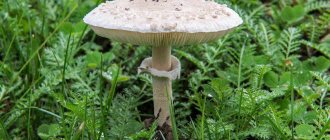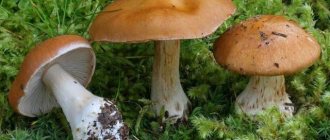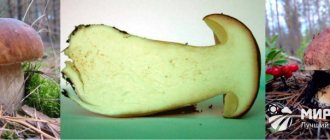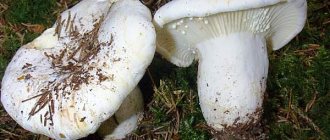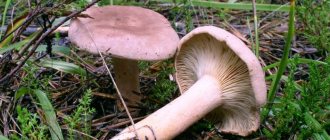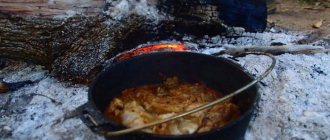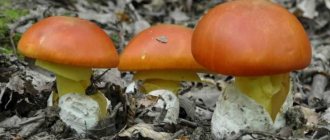Mushrooms of the Champignon family have high culinary value, they are tasty and will decorate any table. The blushing umbrella is a popular mushroom from the genus Chlorophyllum, but, despite its high taste and nutritional qualities, the variety rarely finds its way into the basket of even very experienced mushroom pickers. This is due to fears of poisoning.
This species has several poisonous counterparts. Therefore, those who want to enjoy delicious mushrooms should very carefully study their characteristics and individual differences.
Where does the blushing umbrella grow?
The favorite places of the chicken coop mushroom are open forest clearings. They can be called quite light-loving. They are often found in open spaces of meadows, clearings and plantings. The habitat is very vast. The blushing umbrella can be found on almost all continents of the globe, with the exception, perhaps, of the harsh, icy Antarctica. The composition of the soil is important for him. There should be enough humus in the soil.
A blushing umbrella is easy money for an experienced mushroom picker. According to the photo and descriptions of the chicken coop mushroom, it grows in groups, and quite numerous ones at that, which makes the task of collecting much easier.
Umbrella blushing grows in open areas
Attention! Mushrooms of this species are collected already in July. Provided there is no extreme cold, an umbrella that turns red in the forests can be found even at the end of October.
This is not a gray fly agaric
Very often, novice lovers of “silent hunting” mistake chicken mushrooms for inedible and do not take them into their basket. But this is completely wrong. These representatives of Rosites belong to the fourth group in terms of their nutritional characteristics. They can be consumed both boiled and salted. They have a very refined mushroom aroma and exquisite taste.
Externally, the ringed caps or chicken caps are very reminiscent of gray fly agarics. But they can be very easily distinguished from the latter. It is enough just to study the inner surface of their cap. There are plates that are yellow and brown in color. A distinctive feature of the fly agaric is that at any age they are always snow-white.
There is also a difference in the structure of the legs. Firstly, there is a ring located just below their cap. It has a color that matches the whole mushroom. A little higher there are small yellowish scales. In addition, the leg itself below the ring is thinner than at the top.
What does a mushroom coop look like?
Among the people, the blushing umbrella has gained its popularity as a “chicken coop” mushroom. This is due to the unusual shape of the young fruiting body. According to the descriptions and photos, the red umbrella mushroom, just rising slightly from the ground, is very similar to an egg with a cracked shell. In addition, according to many gourmets, the taste of this mushroom is very reminiscent of chicken meat.
The name “reddened umbrella mushroom” says a lot. With its appearance, it follows the outline of an umbrella, which opens in rainy weather, gently and carefully enveloping its leg, protecting it from bad weather.
The difference between a blushing umbrella:
- The diameter of the cap is on average from 10 to 20 cm, the surface is scaly, the color is gray, smoothly turning into beige, the color darkens towards the center and becomes brownish-brown.
- The structure of the pulp is loose. The cap is delicate, the leg is fibrous. The pulp is initially white, turns red when damaged, and has no distinct odor.
- The inner side has white or slightly cream colored plates.
- Another distinctive feature of chicken coop mushrooms are the so-called rings on the stalk, somewhat reminiscent of snake skin.
- The spores are white, oval-shaped, smooth.
- The length of the leg is from 10 to 30 cm, the thickness, in some specimens, reaches 5 cm. The color is beige or slightly brownish. There is a thickening at the base.
The diameter of the cap can reach twenty centimeters
Growing
To grow a chicken coop in your dacha, it is best to use spore propagation. To do this you will need:
- In the selected area for planting, remove a 25 cm thick layer of soil.
- Collect about 20–30 mushrooms and pick off their caps.
- Cut the tops into small pieces and soak in rainwater (if this is not available, you can use water from a well, which is left to settle for two days).
- After a day, the mushrooms are kneaded with hands or a wooden mortar until a homogeneous paste is obtained.
- Strain the suspension through a sieve.
- Pour the resulting solution evenly over the prepared area of land.
- Scatter mushroom paste on top.
- Cover the “planting” with soil and water.
Did you know? In 1960, mushrooms were assigned to a separate kingdom of the same name, since during lengthy debates scientists were unable to classify them as either plants or animals.
Chicken coop mushroom - edible or not
The shaggy umbrella mushroom (blushing) attracts with its exotic appearance and is considered one of the most delicious mushrooms; it belongs to the conditionally edible group. The appearance is also not inferior to the taste characteristics. Despite its slight popularity among mushroom pickers (due to its resemblance to dangerous relatives), the chicken coop takes pride of place in the kitchens of many housewives. Basically, only the caps of the blushing umbrella are prepared. The legs are a bit harsh and I rarely use them in cooking.
But still, along with the positive qualities and reviews, the umbrella mushroom also poses a certain threat to people with a sensitive digestive tract. Microelements that are part of the pulp can cause digestive system upset if consumed raw or undercooked.
Attention! You should be especially careful about mushrooms growing near roadways, garbage dumps, and industrial enterprises. Reddening umbrellas growing in such areas can accumulate toxins, which can lead to complex poisoning.
A blushing umbrella is considered edible
Evaluation of taste qualities, medicinal properties, benefits and possible harm
Connoisseurs of the shaggy umbrella note that it is not only an edible mushroom, but also very tasty, reminiscent of the white meat of domestic chicken. For cooking, it is advisable to collect only young fruiting bodies and separate them from the stem if you plan to eat them without storing them for the winter.
Medicinal properties of chicken coop mushroom:
- strengthens the walls of blood vessels;
- stimulates brain activity;
- increases immunity and the body's resistance to viral infections;
- lowers blood sugar levels;
- slows down the aging process of the body due to the presence of antioxidants;
- promotes the removal of toxins and waste.
Chemical composition of chicken:
- vitamins B, C, E, K;
- potassium (up to 16%), sodium, magnesium, calcium, iron, phosphorus;
- tyrosine;
- arginine;
- beta glucans;
- melanin.
Kurniki are used as a prophylactic against cancer, tuberculosis and viral infections. Extracts of fruiting bodies are used in cosmetology to treat skin inflammation. They help get rid of acne. Lotions made from alcohol tinctures are used to rejuvenate the skin. Traditional healers claim that tinctures from the umbrella help in the treatment of alcoholism, but there is no scientific confirmation of this fact.
It is strictly forbidden to consume any mushrooms for children under 9 years of age, pregnant and lactating women, people with gastrointestinal problems, exacerbations of kidney and liver diseases. It is extremely dangerous to collect mushrooms close to highways, highways, large plants and factories, because they, like a sponge, absorb all harmful substances, pesticides, nitrates, etc.
False doubles of the blushing umbrella
The main reason for such a low popularity of the blushing umbrella is considered to be its similarity to very dangerous and poisonous mushrooms. The main ones are: comb umbrella, chestnut lepiota, Morgan's umbrella.
Lepiota chestnut
Most often, the red umbrella mushroom (Macrolepiotarhacodes) is confused with poisonous fly agarics and toadstools. Even experienced mushroom pickers make mistakes.
First of all, you need to pay attention to:
- shape and thickness of the leg;
- shade and pattern on the cap;
- painting the inner surface of the cap;
- texture and relief on the leg.
Also not least on the list of dangerous doubles are the so-called false umbrellas. The species belong to the same family and it is often difficult to distinguish a poisonous specimen from an edible relative.
One of the most dangerous on this list is the comb umbrella. In young specimens, the cap is shaped like a small bell; as it grows, it becomes like a dome with a diameter of 12 to 15 cm. Its surface is reddish-brown or dark brown, covered with orange or pale yellow pointed scales. The leg is cylindrical, low, thin. In young mushrooms, the wide membranous ring is clearly visible; it is white or pink in color, but as it ripens, it quickly disappears. Unlike its edible counterpart, it has an unpleasant odor.
Comb umbrella
Morgan's umbrella
Against the backdrop of all this wealth of species and classes, the main thing is not to get confused and confused at the most necessary moment, to identify “friends among strangers.”
Attention! If you are not completely sure of the identification of the mushroom, it is better not to take it.
Characteristic features of the variety
Despite their geographical widespread distribution, ringed caps are undeservedly ignored
This happens due to the caution of mushroom pickers who confuse edible rosetes with its poisonous counterparts.
Chicken mushrooms really resemble the pale toadstool with its skirt, which is shown in the photo, but after studying the description and differences, you can easily recognize the edible forest delicacy.
Appearance and structure
Appearance changes as it grows. At the beginning of its development, the cap has the shape of a hemisphere with slightly curled edges, which are attached to the stem. The diameter of the cap is up to 4 cm. As it grows, the edges diverge and tear the cover, leaving a ring with a skirt on the leg to prevent tearing. The cap grows up to 10 cm in diameter and takes the shape of a wide cap with a bulge in the center.
The color of the cap is brownish-pink. In dry weather, the edges of the cap dry out and crack slightly. On the inside there are white-yellow plates of the spore apparatus, which acquire a rusty tint during the maturation of the spore powder. The outer side of the cap is dissected with thin creases, covered with a light coating. At the edge, the pollen forms scales that look like those of a fly agaric, which confuses inexperienced mushroom pickers.
You may be interested in:
How to distinguish whether a Polish mushroom is edible or not: useful tips (22 photos) An interesting and most striking representative of the genus of fly mushrooms is the Polish mushroom. It belongs to the second category...Read more...
The pale yellow leg is cylindrical in shape. The structure up to the ring is more silky and bright, above the ring it is scaly and pale. The pulp is dense with a pleasant mushroom smell. The color does not change when cut.
Place of distribution
The species is distributed in Europe, Asia, Japan, and the USA. In Belarus, chickens can be found everywhere. They grow throughout the area and are popular.
Mushroom growth areas
The favorite soil is damp and acidic, on which mixed and coniferous forests, as well as lingonberry and blueberry bushes, are well distributed. You can meet chickens both in the mountains and on the outskirts of swamps, which is why they received another name - marshlanders.
Taste and collection rules
An edible, tasty mushroom, the flesh of which resembles boiled chicken breast, and is consumed fried, stewed, pickled and salted. You should go hunting from July to October-November. If you come across a mycelium of chickens, then, without leaving your spot, you can collect a bucket, because they grow in vast plantations in a circle.
Collection of chickens
Since the marsh grass can be confused with its poisonous twins, when going for this species for the first time, you should take with you someone who understands them, or a picture of the edible and dangerous species. It is also necessary to use the main rule of mushroom pickers: if you’re not sure, don’t take it.
You should not take old, wormy or rotten mushrooms. If these have already ended up in your basket, then you shouldn’t throw them away or trample them, just prick the fruiting body onto a branch, and then, when ripe, it will shed spores and increase the yield.
How to distinguish from false, inedible
The ringed cap has two terrible doubles with which an inexperienced mushroom picker can confuse it - the fly agaric and the toadstool. You can distinguish it from a fly agaric by the following characteristics:
- the scales on the fly agaric cap extend over the entire area, but on the cap only along the edge;
- The smell of the pulp of an inedible mushroom is unpleasant, while that of an edible one is mushroom-like;
- the plates of the fly agaric are free, those of the cap are adherent to the stem;
- the fly agaric has a vulva at the base, the chicken does not.
When comparing with a pale grebe, pay attention to the following signs:
- Edible mushrooms do not have a sac-like formation at the base of the stem;
- The toadstool has fused plates, but the cap does not.
Pale toadstool often grows among caps, therefore, having discovered a rich clearing, it is necessary to inspect each fruiting body that is placed in the basket.
Rules for collecting a chicken coop
The season for collecting blushing umbrellas is no different from others, as it coincides with the fruiting of most species and classes of mushroom families. This mushroom appears in forests at the end of summer and is most often found in September. This is considered to be the first wave of collection.
The second wave of fruiting is the month of October. The edible chicken coop has a typical light aroma even directly during collection. Experienced mushroom pickers know that you can find mushroom clearings not only in the forest, but also in clearings, plantings, and open spaces of pastures.
Redness at the cut site is a characteristic feature of the blushing umbrella, which helps the mushroom picker directly during harvesting not to confuse it with other relatives of this species.
Primary processing and preparation
In gastronomic terms, the chicken mushroom is truly universal. You can prepare it in any way: boil, stew, fry, marinate for the winter, salt. It goes harmoniously with almost all types of vegetables, meat and spices. And to ensure that the dish is truly tasty, regardless of the cooking method, the caps of young specimens are used. Old mushrooms with hardened stems should be discarded, even if they are not damaged by worms.
In addition to excellent nutritional qualities, the ringed cap also has healing properties. Its presence in the diet ensures stable levels of sugar and cholesterol, maintains normal blood pressure, and serves as a preventive measure for a number of infectious diseases.
In the photo there is a ringed cap mushroom
Ringed cap
(
Rozites Cortinarius caperatus
) is popularly called "chicken".
The name is explained very simply: the cap of the young mushroom resembles a cap, and it has a white ring on the stem. True, many other mushrooms are also very similar to caps of different styles, displayed for better viewing on stands in the shape of mushroom legs. It’s not for nothing that the top part of the mushroom is called the cap. It is more difficult to explain why people, apt with names, compared the mushroom to poultry. Maybe its taste is somewhat reminiscent of chicken. Or maybe because this mushroom is usually very clean on the outside, and almost no forest debris sticks to its cap, as if sprinkled with mother-of-pearl powder. This is the association with a neat chicken - a good owner has no place for it to get dirty.
Not everyone, even experienced mushroom pickers, knows about the high culinary merits of this mushroom. For example, the famous Belarusian naturalist writer and mushroom expert Dmitry Bespaly in his book “With a Full Basket” only mentions the existence of such an edible mushroom. Many generally consider him suspicious. There are also certain reasons for this: to some extent, the cap resembles the deadly poisonous pale grebe, primarily with its ring on the stem.
That is why it is best to get acquainted with this mushroom with the help of an experienced person who has collected caps more than once and knows them well.
The mushroom is edible.
The cap is up to 3-10 cm, initially pistil-shaped, then spherical-closed and finally open, smooth, wrinkled and cracked when dry.
Experts pay attention to the peculiar coloring of the top of the cap of the ringed cap. It is necessarily yellowish, light brown in color and seems to be slightly covered with pearl dust, which is why it has a peculiar shining hue
It is distinguished from other lamellar mushrooms and from the same pale toadstool by the clayey, brownish color of the plates, lighter in young mushrooms and richer in old ones. If it seems that the plates are more gray than light brown, then it is better not to take such a mushroom at all until you learn to recognize the cap in any situation.
As can be seen in the photo, the leg of the ringed cap is long, up to 12 cm high, up to 3 cm in diameter, with a whitish ring in the form of an attached thin film:
The leg is smooth, dense, yellowish, slightly scaly above the ring, at the base with a remnant of a tuber, usually disappearing or barely noticeable.
The pulp is yellowish with a pleasant smell and taste. The cap is not inferior in taste to champignons.
It grows very abundantly in pine forests among mosses, on soil with high peat and in spruce forests on acidic soil. There they grow in large groups, although always at some distance from each other. Most often, especially in the depths of the forest, chickens reach a small size; with age, the caps become flat, with a diameter no larger than a large apple. But sometimes there are unusually many of them.
Fruits from July to October.
It differs from inedible cobwebs (Cortinarius) by the absence of an unpleasant odor and the presence on the stem of a well-developed ring with a double edge.
See what the ringed cap mushroom looks like in these photos:
How to cook chicken coop mushrooms
Mother nature gives a huge amount of benefits, demanding in return only careful treatment. Each region is rich in different types of dishes, which in the skillful hands of housewives turn into exquisite dishes, individual culinary masterpieces. Mushrooms have always occupied an important place at the festive table. And not in vain, because with all their availability and popularity, they contain a lot of vitamins A and B, microelements and beneficial properties that have a beneficial effect on the body.
You can prepare chicken coop mushrooms in various ways.
There are several general preparation rules that also apply to blushing umbrellas:
- clean from forest dirt;
- rinse under running water;
- dry, salt, boil.
Well, then a flight of fancy - fried, boiled, stewed, marinated, in batter, with or without sauce. There are many recipes for preparing chicken coop mushrooms. At the same time, every housewife strives to add her own flavor to the dish.
There are many recipes for cooking mushrooms
Benefit
The chicken mushroom, photos and descriptions of which are not very common, has a lot of useful properties that are characteristic of the entire Champignon family.
- It is used in folk medicine (in official medicine they use its captive-bred brother, the champignon).
- The mushroom is a storehouse of useful substances, vitamins and minerals.
- It has a pleasant taste and is therefore excellent for cooking.
- Since the mushroom contains a lot of protein, it is excellent for the diet of athletes, stimulating the growth of muscle mass.
- Improves the functioning of the cardiovascular system.
- Useful for diabetics as it can lower blood sugar levels.
- The mushroom can be grown in the garden, as it is a member of the champignon family.
Signs of Lepiota russets poisoning
The first symptoms of intoxication appear within 10-15 minutes after the poisonous mushroom enters the digestive tract. Next, toxic substances enter the bloodstream. Profuse vomiting begins, white foam appears on the lips. Body temperature rises sharply. Blueish spots may appear on the skin, and it becomes difficult to breathe. The limbs may fail (this is a sign of damage to the central nervous system), and cardiac arrest is possible within 30-35 minutes.
If a person has eaten this deadly poisonous mushroom, they should immediately try to induce vomiting before toxic substances enter the bloodstream. Call an ambulance immediately and give plenty of fluids until it arrives.
IMPORTANT! Red-brown lepiota has not yet been studied enough, so there is no antidote yet.
Application in medicine
Dried and powdered mushrooms are used as a local antiseptic . They can treat purulent wounds. Just 2 g of the product applied to the wound will eliminate the copious secretion of ichor and relieve swelling at the site of inflammation in just 2 days. In folk medicine, a decoction of 100 g of dried mushrooms in 2 liters of water is used for rheumatism . 20 ml of the product (single dose), drunk in the morning and evening for 5 days, will help cope with back pain.

